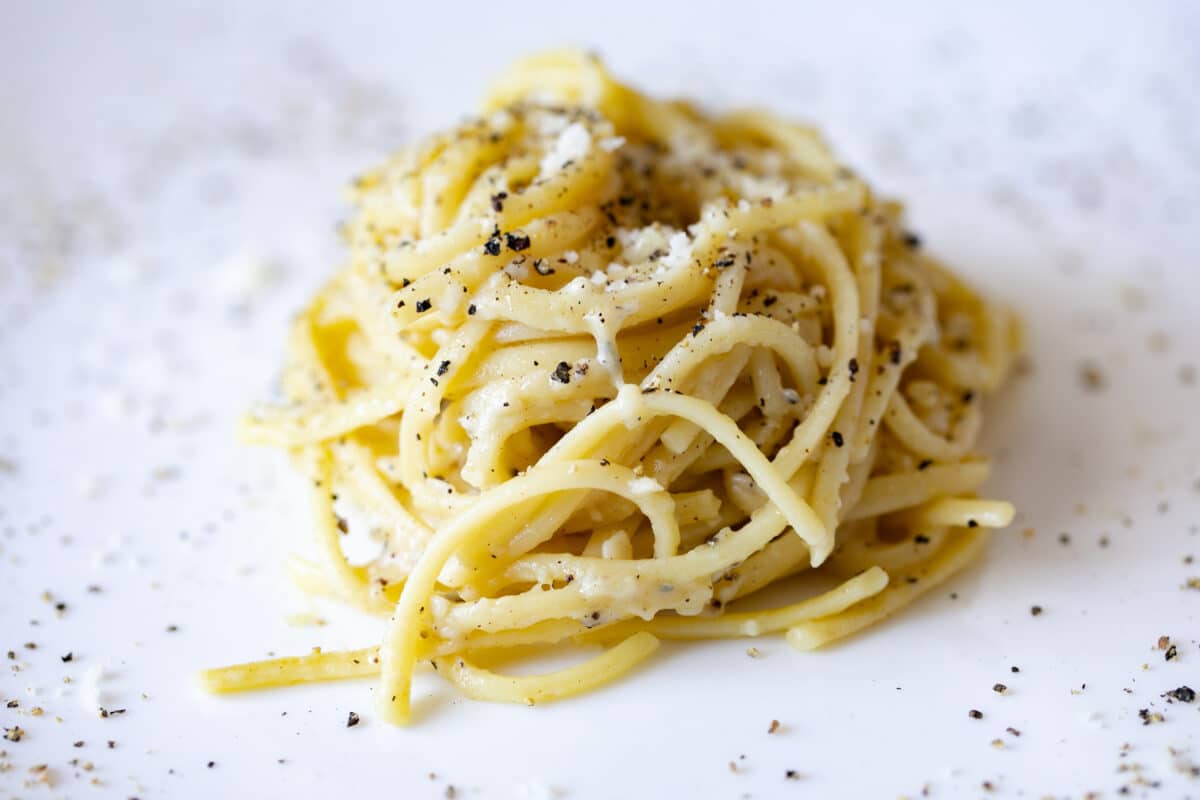
Cacio e pepe is an iconic pasta dish that is also frustratingly difficult to make. A group of Italian scientists studied what makes it fall apart to better understand how to make it more reliably. (Credit: Simone Frau)
In a nutshell
- Starch concentration is the key to perfect Cacio e Pepe – you need at least 1% starch relative to cheese mass to prevent clumping.
- The ideal temperature matters – cheese proteins start to clump at around 65°C (149°F) if there isn’t enough starch to stabilize them.
- For foolproof results, use 5g of starch dissolved in water per 200g of cheese rather than relying solely on pasta water with uncertain starch levels.
DRESDEN, Germany — If you’ve ever tried making Cacio e Pepe at home, you know the heartbreak. One minute you’re expecting a smooth, velvety sauce, and the next you’re staring at a stringy, clumpy mess that resembles failed mozzarella more than a restaurant-worthy dish.
A team of physicists has tackled this kitchen disappointment head-on, bringing scientific rigor to this beloved Roman pasta dish. Their research, published in Physics of Fluids, reveals exactly why your cheese sauce keeps separating and—more importantly—how to fix it.
The Science Behind the Sauce
The researchers discovered that the secret lies in starch concentration. You need at least 1% starch relative to cheese mass to prevent what they’ve dubbed the “Mozzarella Phase”—those disappointing large clumps that ruin the dish’s texture.
“Despite its simple ingredient list, achieving the perfect texture and creaminess of the sauce can be challenging,” note the authors in their paper, accurately describing the frustration many home cooks have experienced.
To investigate, the scientists built a testing setup that allowed them to prepare mixtures with different amounts of pecorino cheese, water, and starch. They heated these mixtures to specific temperatures and photographed the results under special lighting to measure exactly how big the cheese clumps became under different conditions.

Breaking Down the Perfect Recipe
From their experiments, the researchers created a detailed chart showing which combinations of starch, cheese, and temperature work best. For home cooks, their findings mean that controlling starch concentration is crucial, and when pasta water doesn’t have enough starch, the sauce breaks apart once temperatures exceed 65°C (149°F).
The study explains why experienced cooks often use pasta water “risottata”—water that’s been boiled down to concentrate its starch content. Without sufficient starch, proteins in the cheese denature when heated, clumping together and ruining the sauce’s smooth texture.
The scientists even tested an alternative: trisodium citrate. When added at concentrations above 2% relative to cheese mass, it completely prevented clumping. While effective, this additive slightly mutes the cheese flavor and isn’t part of the authentic recipe.
Your Foolproof Formula
Based on all their testing, the scientists offer a reliable recipe. For two people, they recommend:
- 300g of pasta
- 200g of cheese
- 5g of starch dissolved in 150g of water
They advise against relying solely on pasta water for starch, since its concentration can vary. Instead, adding powdered starch ensures consistent results.
While Italian grandmothers have mastered this dish through years of experience, science has now given the rest of us the precise measurements needed to avoid pasta disappointment. This research bridges traditional cooking wisdom with measurable scientific principles, offering hope to home cooks who’ve struggled with this deceptively simple dish.
Paper Summary
Methodology
The researchers conducted controlled experiments using Pecorino Romano DOP cheese mixed with water containing varying concentrations of corn starch. They heated these mixtures at systematic temperature increments from 50°C to 95°C using a sous vide setup, photographing samples at each stage to document the formation of protein aggregates. Using quantile thresholding image analysis, they detected and measured cheese clumps, approximating them as ellipses and using the major axis as the “aggregate size” to quantify sauce stability. They created phase diagrams showing the relationship between starch concentration, temperature, and clump formation. They also tested trisodium citrate as an alternative stabilizer and developed a theoretical model to explain their observations.
Results
The study found that starch concentration is critical for sauce stability, with concentrations below 1% (relative to cheese mass) resulting in large system-wide clumps (“Mozzarella Phase”) at temperatures around 65°C. Higher starch concentrations (2-3%) prevented large aggregates even at high temperatures. When analyzing the effect of cheese concentration at fixed starch levels, they observed a parabolic phase boundary with an optimal protein mass fraction near 0.134 (achieved with water and cheese in 1:1 proportion). They also discovered that trisodium citrate above 2% concentration completely prevented aggregation, providing superior stability compared to starch but at the cost of slightly altered flavor. Based on their findings, they developed a precise recipe recommendation for consistently perfect Cacio e Pepe.
Limitations
The researchers acknowledge that their simple binary mixture model has limitations in fully capturing the complex molecular interactions in cheese sauce. They suggest that more detailed models considering multiple protein states and starch-mediated complexes could provide better insights. The study focused on controlled laboratory conditions rather than real kitchen scenarios where heating rates may differ significantly. Additionally, they note that while trisodium citrate offers superior stabilization, it alters the traditional taste of the dish, presenting a tradeoff between consistency and authenticity.
Funding/Disclosures
The authors acknowledge support from Frank Jülicher, who supported the initiative and participated in stimulating discussions. The study appears to be a collaborative effort among researchers from multiple European institutions including the University of Barcelona, Max Planck Institute for the Physics of Complex Systems, University of Padova, and Institute of Science and Technology Austria. The paper is part of the Kitchen Flows 2024 special topic collection.
Publication Information
The paper titled “Phase behavior of Cacio e Pepe sauce” was published in Physics of Fluids (Volume 37, 044122) on April 29, 2025. The research was conducted by G. Bartolucci, D.M. Busiello, M. Ciarchi, A. Corticelli, I. Di Terlizzi, F. Olmeda, D. Revignas, and V.M. Schimmenti from various European institutions.







